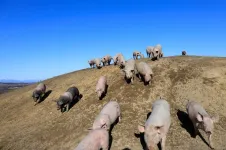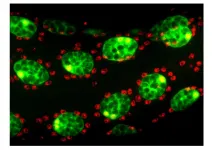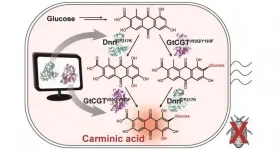(Press-News.org) DURHAM, N.C. -- Some guys have it all: the muscle, the power, the high social status, the accelerated aging.
But wait. Faster aging? Who wants that? For male baboons, it's the price they pay to be at the top.
New research appearing April 6 in eLife by Jenny Tung, associate professor of evolutionary anthropology and biology at Duke University, and her colleagues shows that male baboons that climb the social ladder age faster than males with lower social standing. If a male drops in social status, his estimated rate of aging drops as well.
Using blood samples from 245 wild baboons in the Amboseli ecosystem in Kenya, the team analyzed chemical modifications to DNA known as DNA methylation marks.
"These marks change with age in a clock-like fashion," Tung said. "However, environmental stressors can make the clock tick faster." This would make an individual appear older than they really are, and, research in humans suggests, can put them at a higher risk of aging-related disease.
Since this cohort of baboons is one of the most intensively studied wild mammal populations in the world, the researchers already knew not only each baboon's age, but also the environment in which they grew up, their exposure to early life adversity, and a great deal about their adult environment, especially the aspects that predict how long they live and how many offspring they leave behind.
"We used DNA methylation to compare the baboons known ages to their 'biological ages,'" said Jordan Anderson, a graduate student in the Tung lab who co-led the work. These methylation markers are found across the genome, so the team first needed to measure a large number of these sites - about 400,000 of them - and then, through statistical methods and models, whittle the number of sites down to about 500 that best predicted age.
Interestingly, for males, early life adversity didn't affect how fast their biological clocks tick.
Adult social status was the strongest factor that affected aging. "Male baboons who compete successfully for high social status appear to age faster," Tung said. "We repeatedly sampled some of these males and were able to show that the clock can speed up or slow down as males move up or down the social ladder."
This is contrary to what we see in humans. Typically, high social status in humans predicts better health, not worse. The most wealthy and powerful humans have access to and can afford the best houses, schools, healthcare and more. Those who live in poverty and have lower socioeconomic status are at increased risk and have higher rates of disease, cancer and all-cause mortality.
Male baboons, though, have to fight for their social status. Because of this, it's common to see male-male competition on a regular basis, where baboon observers can see a clear winner and a clear loser.
To maintain their social status, males at the top regularly have to hold their ground and defend themselves physically. Because of this, male baboons at the top tend to have more muscle mass and better body condition than lower ranking baboons. But as their physicality starts to diminish with age, a new, younger, stronger male may overcome them for the top spot.
High ranking males also spend a lot of time mate-guarding females. Around ovulation, they follow females closely and ward off other males. Mate-guarding constrains a male's other activities, and Tung and her team think it is likely to be energetically costly -- perhaps helping to explain their accelerated aging result.
So why do these males work so hard to achieve a high stress social status? It's simple: to have offspring.
"If male baboons are going to have babies, they need to achieve high rank," Tung said. "They will have very little chance to leave offspring if they don't achieve high rank, which creates a powerful evolutionary motivation."
This study highlights one way that the social environment can influence aging. "Our research shows that the manner in which social status is attained and maintained is crucial to understanding its consequences," Tung said.
INFORMATION:
This research was supported by the US National Science Foundation and the US National Institutes of Health, Canadian Institute of Advanced Research, North Carolina Biotechnology Center, and the Center for Population Health and Aging. (2018264636, IOS1456832, R01AG053308, R01AG053330, R01HD088558, P01AG031719, F32HD095616, 2016-IDG-1013, P30AG034424)
CITATION: "High Social Status Males Experience Accelerated Epigenetic Aging in Wild Baboons," Jordan A. Anderson, Rachel A. Johnston, Amanda J. Lea, Fernando A. Campos, Tawni N. Voyles, Mercy Y. Akinyi, Susan C. Alberts, Elizabeth A. Archie, Jenny Tung. eLife, April 6, 2021. DOI: 10.7554/eLife.66128
TAMPA, Fla. -- Tumors are genetically diverse with different mutations arising at different times throughout growth and development. Many models have tried to explain how genetic heterogeneity arises and what impact these alterations have on tumor growth. In a new article published in Nature Communications, Moffitt Cancer Center researchers show how the location of the tumor and spatial constraints put on it by the surrounding tissue architecture impact genetic heterogeneity of tumors.
Genetic differences are apparent among tumors from different patients, as well as within different regions of the same tumor of an individual patient. Some of these mutations may benefit the tumor and become selected for, such as mutations that allow the tumor to grow faster and spread to other ...
NASA's Hubble Space Telescope is "seeing double." Peering back 10 billion years into the universe's past, Hubble astronomers found a pair of quasars that are so close to each other they look like a single object in ground-based telescopic photos, but not in Hubble's crisp view.
The researchers believe the quasars are very close to each other because they reside in the cores of two merging galaxies. The team went on to win the "daily double" by finding yet another quasar pair in another colliding galaxy duo.
A quasar is a brilliant beacon of intense light from the center of a distant galaxy that can outshine the ...
Breast cancer survivors with a higher risk of cancer recurrence based on genomic testing may experience greater fear of their cancer returning, according to a new study led by researchers at NYU Rory Meyers College of Nursing. However, psychological factors such as anxiety are the best predictors of survivors' fear of their cancer recurring.
"Although genomic test results were associated with fear of cancer recurrence, our findings highlight that distressing, but treatable, psychological factors fuel cancer survivors' fear of recurrence," said Maurade Gormley, PhD, RN, an assistant professor and faculty fellow at NYU Meyers and the lead author of the study, which was published in the journal Psycho-Oncology.
For breast cancer survivors, fear and worry that ...
Battling other male baboons to achieve high social status comes with physiological costs that accelerate aging, according to study published today in eLife.
The findings suggest that current life circumstances may be more important contributors to premature aging than early life hardship, at least in baboons.
Chemical changes to DNA, also called epigenetic changes, can be used as a kind of 'clock' to measure aging. While these epigenetic changes usually correspond with age, they can also be used to detect signs of premature aging.
"Environmental stressors can make the clock tick faster, so that some individuals appear biologically older than their actual age and ...
OAK BROOK, Ill. - Screening with digital breast tomosynthesis (DBT) reduces the rate of interval breast cancers compared to screening with digital mammography, according to a study published in Radiology. The study adds to a growing body of evidence supporting DBT as a breast cancer screening tool with important advantages over mammography.
DBT works by capturing a series of X-ray images of the breast from different angles. Previous research has shown that it has a higher sensitivity for breast cancer detection than digital mammography.
The impact of these additional DBT-detected cancers is not fully understood. ...
OAK BROOK, Ill. - Body composition information derived from routine chest CTs can provide important information on the overall health of people with chronic obstructive pulmonary disease (COPD), including their risk of all-cause mortality, according to a study published in Radiology.
COPD is a group of chronic, progressive lung diseases like emphysema and chronic bronchitis that affect about 30 million people in the United States alone. It is frequently associated with obesity and sarcopenia, a loss of muscle mass and strength. Obesity is associated with lower mortality in patients with COPD. The longer survival rates of obese patients compared to leaner counterparts, a phenomenon ...
A statistically rigorous survey of Japanese consumers has found that they have more negative opinions about the use of new gene-editing techniques on livestock than they do about use of the same technologies on vegetables.
The survey findings were reported in the journal BMC CABI Agriculture and Bioscience on March 31st, 2021.
Because humans tend to feel closer to animals than plants, and commonly express feelings regarding animal welfare but not plant welfare, the researchers, led by Naoko Kato-Nitta, a research scientist at Tokyo's Joint Support Center for Data Science Research and Institute of Statistical ...
Even a well-characterized genome, such as that of the Drosophila the so-called fruit fly, still holds surprises. A team from the University of Geneva (UNIGE), Switzerland, in collaboration with Cornell University (USA) and the University of Groningen (Netherlands), has discovered an RNA coding for a micro-peptide - a very small protein - that plays a crucial role in the competition between spermatozoa from different males with which the female mates. In addition to shedding new light on this biological mechanism, this work, to be read in the journal Proceedings of the National Academy of Sciences (PNAS), highlights the importance of small peptides, a class of proteins that ...
Scientists of Tomsk Polytechnic University have synthetized high-entropy carbide consisting of five various metals using a vacuum-free electric arc method. The research findings are published in the Journal of Engineering Physics and Thermophysics.
High-entropy carbides are a new class of materials simultaneously consisting of four or more various metals and carbon. Their main feature lies in the capability to endure high temperatures and energy flux densities. Combining various elements in the composition, it is possible to obtain the required mix of features ...
A research group at KAIST has engineered a bacterium capable of producing a natural red colorant, carminic acid, which is widely used for food and cosmetics. The research team reported the complete biosynthesis of carminic acid from glucose in engineered Escherichia coli. The strategies will be useful for the design and construction of biosynthetic pathways involving unknown enzymes and consequently the production of diverse industrially important natural products for the food, pharmaceutical, and cosmetic industries.
Carminic acid is a natural red colorant widely being used for products such as strawberry milk and lipstick. However, carminic acid has been produced ...








